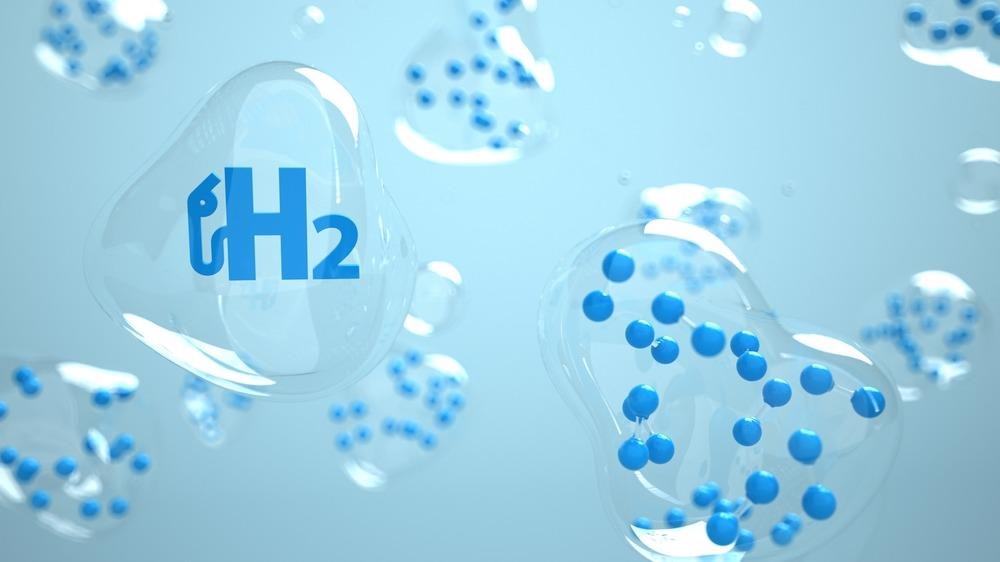In a study published recently in the journal Inorganic Chemistry, using a simple light deposition technique, an improved cocatalyst of gold platinum (AuPt) nanoparticle with an extremely low platinum concentration was effectively ornamented on carbon self-doping graphitic carbon nitride nanosheets.

Study: Which Is More Efficient in Promoting the Photocatalytic H2 Evolution Performance of g-C3N4: Monometallic Nanocrystal, Heterostructural Nanocrystal, or Bimetallic Nanocrystal? Image Credit: Alexander Limbach/Shutterstock.com
What is Graphitic Carbon Nitride?
Society's long-term growth is jeopardized by the escalating climate change and energy crises. As a result, it is critical to develop sustainable energy sources.
Among these, photocatalytic hydrogen (H2) generation is seen as a possible option. Several studies have been conducted to produce effective semiconductor photocatalytic activity utilizing metal oxides, metal sulfides, and organic metal structures.
Nevertheless, these photocatalysts have a low absorption spectrum due to their large bandgap, photodegradation, and difficult fabrication procedures, which severely limits their actual photocatalytic activities. Thus, the synthesis of photocatalysts with good sunlight absorption, particularly visible absorptivity, exceptional physicochemical stability, and a simple manufacturing technique is critical.
Graphitic carbon nitride (gC3N4) has sparked a lot of attention in this regard.
Its visible region output, high chemical stability, ease of production, and adequate negative valence band for hydrogen development are all benefits of graphitic carbon nitride. Still, due to a lack of surface reactive groups, pure graphitic carbon nitride exhibits poor optical absorption, a high charge carrier dispersion rate, and a restricted reaction rate.
To address the g-inherent C3N4's drawbacks, immense research has been conducted, including optimizing the morphological structure for a strongly lattice, amorphous, and tapered graphitic carbon nitride. Amongst them, decorating appropriate cocatalysts on graphitic carbon nitride was effective due to cocatalysts' stellar showing in improving graphitic carbon nitride photoabsorption, charge transfer dissociation, and hydrogen production rates.
Problems in g-C3N4
Plasmonic metals, particularly gold (Au) and silver (Ag) nanoparticles (NPs) were demonstrated as excellent cocatalysts to decorate graphitic carbon nitride for improved visible region. However, platinum (Pt) nanostructures were shown to be far better than gold or silver nanomaterials in terms of increasing photo-induced electron-hole pairs dissociation as well as hydrogen generation capability of graphitic carbon nitride via hydrogen production.
This finding implied that nanostructured cocatalysts, in general, were incapable of boosting the entire photocatalytic hydrogen supply chain of graphitic carbon nitride. Moreover, due to the synergistic effects of multiple elements, multimetallic nanomaterials consisting of two or more unique metals usually display greater physicochemical characteristics than their respective individual metals, resulting in an exceptional performance enhancement.
Given the operational excellence of gold nanoparticles in improving photocatalytic optical absorption and platinum's outstanding catalytic hydrogen evolution efficiency, it is logical to presume that amending gold-platinum bimetallic nanomaterials on photocatalysts could significantly improve photocatalytic hydrogen adaptation efficiency. However, published research on gold-platinum bimetallic for photocatalytic hydrogen production is few.
Use of AuPt Nanoparticles
In this study, gold-platinum (AuPt) alloyed nanoparticles with extremely low platinum concentration were coated on carbon self-doping graphitic carbon nitride nanosheets (AuPt/CCN) using a simple light coating approach for resilient photocatalytic hydrogen production.
CCN rather than graphitic carbon nitride was employed because it has a higher thermal conductivity, which aids in the transmission and segregation of photogenerated electrons. Furthermore, due to the sheer considerably improved conductance of CCN obtained by self-doping graphene, the gold-platinum nanocomposite could be more efficiently and deeply coated on the exterior of CCN during the photo deposition procedure.
The nearness and electronegativity distinction of gold and platinum atoms in gold-platinum accelerated charge transport transfer and detachment; and the synergistic interaction between platinum and Au atoms optimized the Gibbs free energy (GH*) of H* (atom) adsorption on platinum, promoting the AuPt/CCN hydrogen generation dynamics.
Achieved Outcomes
A durable cocatalyst of gold-platinum nanoparticles with extremely low platinum concentration was effectively changed on the surface of graphene self-doping graphitic carbon nitride nanosheet (AuPt/CCN) through a simple photo coating approach.
The exploratory and density functional theory calculations revealed that the addition of gold-platinum nanomaterials ramps up charge transport transmission and extraction efficiency due to the closeness and valence distinction of gold and gold-platinum atoms in gold-platinum and encourages hydrogen generation reaction rates due to the combined engagement between platinum and gold atoms.
As a result, the electrochemical hydrogen generation capability of AuPt/CCN was greatly enhanced. Due to powerful synergistic effects extracted from various metal alloys, this project showed that multimetallic nanocrystals may function more efficiently than bimetallic nanocrystals or heterojunction nanocrystals in boosting the photocatalytic efficiency of graphitic carbon nitride processes, promoting photocatalytic hydrogen manufacturing.
Reference
Li, L., Wang, X., Gu, H., Zhang, H., Zhang, J., Zhang, Q., and Da, W.-L. (2022). Which Is More Efficient in Promoting the Photocatalytic H2 Evolution Performance of g‑C3N4: Monometallic Nanocrystal, Heterostructural Nanocrystal, or Bimetallic Nanocrystal? Inorganic Chemistry. Available at: https://pubs.acs.org/doi/10.1021/acs.inorgchem.2c00171
Disclaimer: The views expressed here are those of the author expressed in their private capacity and do not necessarily represent the views of AZoM.com Limited T/A AZoNetwork the owner and operator of this website. This disclaimer forms part of the Terms and conditions of use of this website.